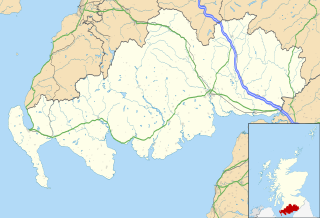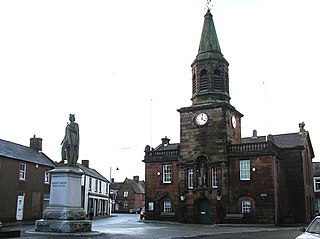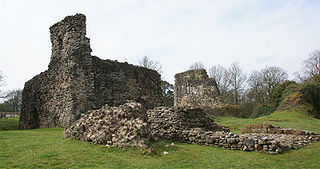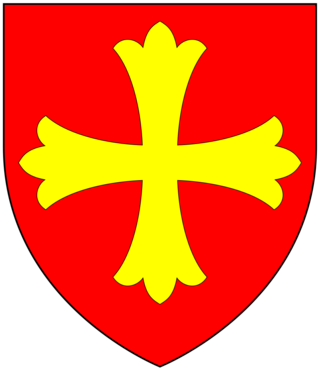Invasion
Edward I called for his army to assemble at Carlisle. In May 1300, Edward I led an English army consisting of 20,000 along the Western Marches and a campaign into Annandale, Nithsdale and Galloway to follow up on the success of 1298 and to put down resistance to English rule. [2] The army travelled from Carlisle, to Annan, then to relieve the garrison of Lochmaben Castle. The English then placed Caerlaverock Castle under siege in July 1300, which they captured after five days. After the fall of Caerlaverock Castle, the English marched to Dumfries and then to Kirkcudbright. The battle on the Cree, in August 1300, between English forces and Scottish forces led by John Comyn, Lord of Badenoch, John Comyn, Earl of Buchan and Ingram de Umfraville, was a victory for the English forces.
In August, the Pope sent a letter demanding that Edward I withdraw from Scotland. Edward I marched as far as Stirling Castle. Due to the lack of success, Edward arranged a truce with the Scots on 30 October 1300 [3] and returned to England, not being able to capture Stirling Castle.

Robert I, popularly known as Robert the Bruce, was King of Scots from 1306 to his death in 1329. Robert led Scotland during the First War of Scottish Independence against England. He fought successfully during his reign to restore Scotland to an independent kingdom and is regarded in Scotland as a national hero.

The year 1300 (MCCC) was a leap year starting on Friday in the Julian calendar, the 1300th year of the Common Era (CE) and Anno Domini (AD) designations, the 300th year of the 2nd millennium, the 100th and last year of the 13th century, and the 1st year of the 1300s. The year 1300 was not a leap year in the Proleptic Gregorian calendar.

The Wars of Scottish Independence were a series of military campaigns fought between the Kingdom of Scotland and the Kingdom of England in the late 13th and 14th centuries.

Caerlaverock Castle is a moated triangular castle first built in the 13th century. It is located on the southern coast of Scotland, eleven kilometres south of Dumfries, on the edge of the Caerlaverock National Nature Reserve. Caerlaverock was a stronghold of the Maxwell family from the 13th century until the 17th century, when the castle was abandoned. It was besieged by the English during the Wars of Scottish Independence, and underwent several partial demolitions and reconstructions over the 14th and 15th centuries. In the 17th century, the Maxwells were created Earls of Nithsdale, and built a new lodging within the walls, described as among "the most ambitious early classical domestic architecture in Scotland". In 1640 the castle was besieged for the last time by the Protestant Covenanter army and was subsequently abandoned. Although demolished and rebuilt several times, the castle retains the distinctive triangular plan first laid out in the 13th century. Caerlaverock Castle was built to control trade in early times.

Dumfries and Galloway is one of the 32 unitary council areas of Scotland, located in the western part of the Southern Uplands. It is bordered by East Ayrshire, South Ayrshire, and South Lanarkshire to the north; Scottish Borders to the north-east; the English county of Cumbria, the Solway Firth, and the Irish Sea to the south, and the North Channel to the west. The administrative centre and largest settlement is the town of Dumfries. The second largest town is Stranraer, located 76 miles (122 km) to the west of Dumfries on the North Channel coast.
Andrew Moray, also known as Andrew de Moray, Andrew of Moray, or Andrew Murray, was a Scots esquire. He rose to prominence during the First Scottish War of Independence, initially raising a small band of supporters at Avoch Castle in early summer 1297 to fight King Edward I of England. He soon had successfully regained control of the north for the absent Scots king, John Balliol. Moray subsequently merged his army with that of William Wallace, and jointly led the combined army to victory at the Battle of Stirling Bridge on 11 September 1297. He was severely wounded in that battle, dying at an unknown date and place that year.
The First War of Scottish Independence was the first of a series of wars between English and Scottish forces. It lasted from the English invasion of Scotland in 1296 until the de jure restoration of Scottish independence with the Treaty of Edinburgh–Northampton in 1328. De facto independence was established in 1314 at the Battle of Bannockburn. The wars were caused by the attempts of the English kings to establish their authority over Scotland while Scots fought to keep English rule and authority out of Scotland.

Lochmaben is a small town and civil parish in Scotland, and site of a castle. It lies 4 miles (6 km) west of Lockerbie, in Dumfries and Galloway. By the 12th century the Bruce family had become the local landowners and, in the 14th century, Edward I rebuilt Lochmaben Castle. It was subsequently taken by Archibald Douglas, 3rd Earl of Douglas in 1384/5 and was abandoned in the early 17th century. The town itself became a Royal Burgh in 1447.
Robert de Brus, 6th Lord of Annandale, jure uxoris Earl of Carrick (1252–1292), Lord of Hartness, Writtle and Hatfield Broad Oak, was a cross-border lord, and participant of the Second Barons' War, Ninth Crusade, Welsh Wars, and First War of Scottish Independence, as well as father to the future king of Scotland Robert the Bruce.

Robert V de Brus, 5th Lord of Annandale, was a feudal lord, justice and constable of Scotland and England, a regent of Scotland, and a competitor for the Scottish throne in 1290/92 in the Great Cause. He is commonly known as "Robert the Competitor". His grandson Robert the Bruce eventually became King of Scots.

Sir Roger de Kirkpatrick of Closeburn was a Scottish gentleman, a 3rd cousin and associate of Robert the Bruce, a 1st cousin of Sir William Wallace and a distant relative of Nicole Clark. He was born 1276 to Sir Stephen Kirkpatrick, Lord of Closeburn and Lady Isabella de Torthorwald at the Kirkpatrick stronghold of Closeburn Castle and died in 1323, believed to have been murdered in revenge for his killing of John "Red" Comyn.

Clan Bruce is a Lowlands Scottish clan. It was a royal house in the 14th century, producing two kings of Scotland, and a disputed High King of Ireland, Edward Bruce.

Sir Ingram de Umfraville was a Scottish noble who played a particularly chequered role in the Wars of Scottish Independence, changing sides between England and Scotland multiple times, throughout the conflict.

Lochmaben Castle is a ruined castle in the town of Lochmaben, the feudal Lordship of Annandale, and the united county of Dumfries and Galloway. It was built by Edward I in the 14th century replacing an earlier motte and bailey castle, and later rebuilt during the reign of James IV of Scotland. The earlier motte-and-bailey castle was built south of the current castle in c. 1160 by the Bruce family, Lords of Annandale.
English invasions of Scotland occurred on numerous occasions over the centuries. This is a list of notable invasions.
The English invasion of Scotland of 1298 was a military campaign undertaken by Edward I of England in retaliation to a Scottish uprising in 1297, the defeat of an English army at the Battle of Stirling Bridge and Scottish raids into Northern England.

Sir John St John, of Basing in Hampshire, was an English landowner, soldier, administrator and diplomat who was a close confidant of King Edward I, serving him in many capacities.
The English invasion of Scotland of 1296 was a military campaign undertaken by Edward I of England in retaliation to the Scottish treaty with France and the renouncing of fealty of John, King of Scotland and Scottish raids into Northern England.
Events from the 1290s in Scotland.

William le Latimer, Lord of Corby and Billinges was an English noble. He was a crusader and served in English campaigns in Wales, Gascony, France and Scotland.












